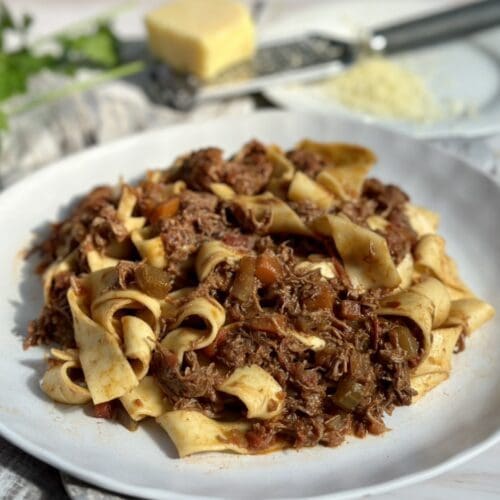
Duck Ragu
Silky smooth ribbons of pappardelle pasta in tasty, rich tomato & wine sauce. This slow-cooked Duck Ragu is both comforting and fancy!
Ingredients
- 1 tbsp mild/light olive oil
- 800 gm duck breasts (NOTE 1)
- 3 garlic cloves
- 1 small brown onion
- 1 cup diced celery
- 1 cup diced carrots
- 1 cup red wine (NOTE 2)
- 800 gm crushed tomatoes (2 x 400g/ 14oz tins)
- 1 cup salt-reduced chicken stock (NOTE 3)
- 2 dried bay leaves
- 1 tsp ground cinnamon
- 2 tsp chicken powder (NOTE 4)
- 1 tsp sugar
- 1 tsp salt
- ½ tsp freshly ground black pepper
- 500 gm dried pappardelle pasta (NOTE 5)
- Optional - parmesan cheese to serve
Instructions
- Heat the oil over medium heat in a large cast iron pot. Place the duck breasts skin down onto the oil and leave for 4 to 5 minutes until the fat renders and the skin is nice and brown. Turn the duck over and brown the other side for 2 to 3 minutes, then transfer onto a plate and set aside for later.Drain the duck fat, leaving approximately 1 or 2 tablespoons in the pot. Keep the fat for other uses later.
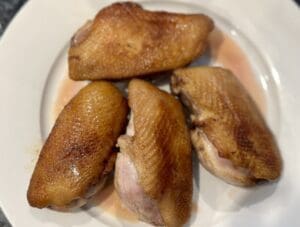
- In the same pot, add the garlic and onions. Stir regularly for a minute, then add the carrots and celery and stir for 2 minutes. Pour in the wine and stir for a minute, then add in the tomatoes, stock, bay leaves, cinnamon, chicken powder, sugar, salt and pepper. Bring the sauce to a boil, then reduce heat to low and add the duck breasts along with its juices (skin up) then cover. Slow-cook the ragu for 2 to 2.5 hours or until the duck breasts are tender.
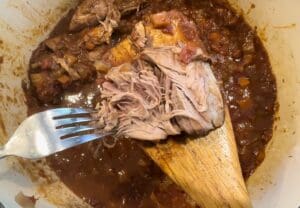
- Transfer the duck onto a board or plate, then remove the skin (discard or chop it into small pieces and place it back into the ragu). Use two forks to shred the duck, then return it to the pot. Increase the heat to medium and reduce the sauce to your liking (the sauce is supposed to be thin). Have a taste of the ragu and add more salt and pepper to your liking if needed.
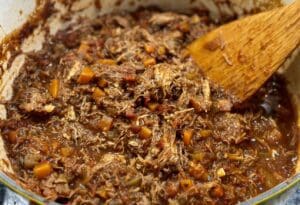
- Whilst the ragu has 10 minutes left remaining, prepare the pasta. Cook the pasta as per the instructions on the packet. Before draining the pasta, reserve a cup of pasta water.Heat a frying pan over medium heat. Working in batches, add in a few ladles of ragu and some pasta. Pour in 1 or 2 tablespoons of pasta water to loosen up the ragu if needed. Toss the pasta so it's covered in the ragu and cook for 2 to 3 minutes or just until heated through. Sprinkle on some freshly grated parmesan (optional) and serve immediately.
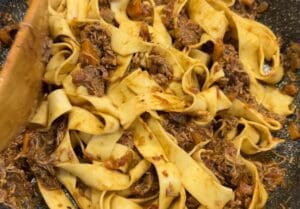
Notes
(NOTE 1) Duck breasts - I used 4 skin-on duck breasts (approx 800gm/ 1.8lbs in total). You could swap duck breasts for 1.2 kg/ 2.6lb of duck legs or whole duck.
(NOTE 2) Red wine - My personal tip for using red wine, is to use a cheap one that you enjoy drinking. Wine is quite strong tasting, so it affects the overall flavour of the dish so it's best to use one you like! My cheap wine is a red blend and is on the sweet side and I love cooking with it. If you're not a wine drinker, choose dry red wine (Pinot Noir, Merlot, Cabernet Sauvignon Shiraz). If you rather not use wine, swap for equal amounts of salt-reduced chicken stock or broth.
(NOTE 3) Chicken stock/broth - I prefer using salt-reduced (low-sodium) chicken stock because I have more control over the sodium level. This way I can adjust the seasoning in dishes to my liking. It's always better to be under-seasoned than over-seasoned as it's easier to fix.
(NOTE 4) Chicken powder - I cannot live without Knorr Chicken Powder (not sponsored). It seriously enhances the taste in many of my savoury dishes. Although I highly recommend this brand, other chicken powder or chicken bouillon cubes would work as a substitute.
(NOTE 5) Pappardelle pasta - I recommend good quality dried or fresh pappardelle pasta with this ragu. Fettuccine, tagliatelle or any flat long pasta would also work nicely.
Leftovers - Allow the ragu to cool completely at room temperature, then transfer them into a sealed container and store them in the fridge for up to 3 days.
I've used a third-party application to calculate the calories and nutritional information, so please use this as an approximate guide only.
Cooking measurements are in Australian standard spoon and cup measurements. For specific details and conversions, visit our Australian Cooking Measurements page.
Nutrition
Serving: 1 ServingCalories: 510kcalCarbohydrates: 76gProtein: 42gFat: 13gSaturated Fat: 3gPolyunsaturated Fat: 2gMonounsaturated Fat: 5gTrans Fat: 0.1gCholesterol: 173mgSodium: 865mgPotassium: 1175mgFiber: 7gSugar: 10gVitamin A: 4053IUVitamin C: 24mgCalcium: 108mgIron: 10mg